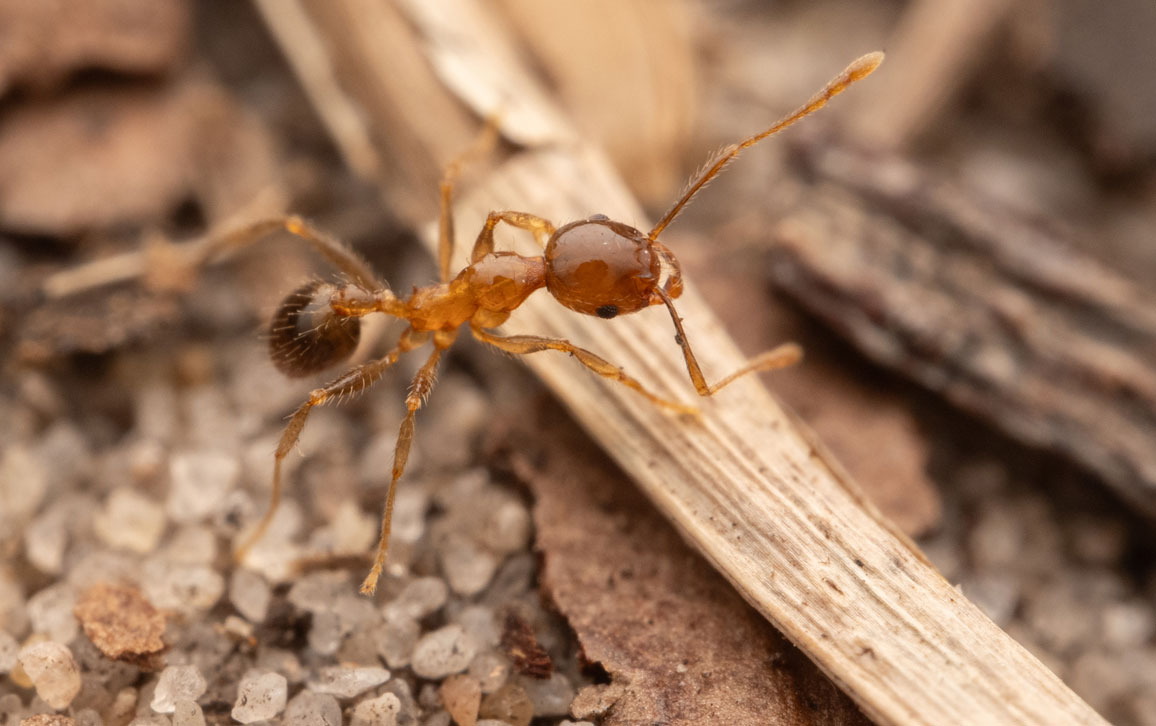
This Article From Issue
May-June 2024
Volume 112, Number 3
Page 141
In this roundup, managing editor Stacey Lutkoski summarizes notable recent developments in scientific research, selected from reports compiled in the free electronic newsletter Sigma Xi SmartBrief: www.smartbrief.com/sigmaxi/
Invasive Insects Alter Lions’ Diet

Philipp Hoenle
A non-native species of ants has shown how one tiny, invasive species can have knock-on effects that alter an entire ecosystem, including the behaviors of the largest animals and predators. Across the savannas of East Africa, native acacia ants (several Crematogaster species) live in whistling-thorn trees (Vachellia drepanolobium), which provide them with shelter and nectar. The ants, in turn, protect their homes by biting and stinging elephants that would attempt to eat or trample the trees. Lions also rely on the whistling-thorn trees as cover when hunting zebras. Invasive big-headed ants (Pheidole megacephala) have disrupted this ecosystem’s delicate mutualism. The foreign ants overwhelm the acacia ants, killing the adults and eating their eggs. Without the acacia ants’ protection, the whistling-thorn trees fall victim to elephant herds, which in turn reduces lions’ coverage when hunting. Zebra kills have dropped significantly in areas where big-headed ants are present, but the lion populations have not declined, probably because they switched to hunting African buffalo. The long-term effect of switching prey species is not yet known. The remarkable change one invasive insect can make on an ecosystem demonstrates the importance of fragile mutualisms in maintaining environmental health.
Kamaru, D. N., et al. Disruption of an ant-plant mutualism shapes interactions between lions and their primary prey. Science 383:433–438 (January 25).
Martian Pull on Earth’s Oceans
Gravitational forces from Mars may contribute to deep whirlpools that disrupt the seafloor on Earth. A team of geoscientists led by Adriana Dutkiewicz of the University of Sydney in Australia found that periods of significant sediment disruption correspond with the 2.4-million-year cycle of Earth–Mars resonance—times when the planets’ gravities push and pull on each other. These astronomical grand cycles are difficult to detect, and there had been scant evidence of how interactions between planets affect the climate on such long timescales. The researchers applied spectral analysis to data collected from 293 deep-sea drill holes across all of Earth’s oceans. Underwater currents move sand and other materials along the ocean floor in fairly regular patterns, but striations in these samples indicate periods of greater disruption. Previous studies had looked at these seemingly anomalous striations over thousands of years and not found a pattern, but Dutkiewicz’s team widened their scope to millions of years and found that the ebb and flow of the currents correlate with astronomical grand cycles. Every 2.4 million years, Earth and Mars fall into a resonant pattern of motion; at those times, the enhanced effect of Mars’s gravity alters the shape of Earth’s orbit, bringing Earth slightly closer to the Sun and triggering a cascade of climate effects (unrelated to human-caused climate change). These small changes in the tiny pull of Mars boost ocean circulation on Earth, which in turn increases disruption of the ocean floor. (See“Operational Oceanography,” March–April 2022.) The study indicates that widening perspectives to astronomical scales may identify more ways that the Earth is part of a larger, interplanetary system.
Dutkiewicz, A., S. Boulila, and R. D. Müller. Deep-sea hiatus record reveals orbital pacing by 2.4Myr eccentricity grand cycles. Nature Communications 15:1998 (March 12).
Unfocused Foraging
The seemingly modern problem of short attention spans may have had an evolutionary advantage in hunter-gatherer societies. Researchers have suspected that neurological differences such as attention deficit hyperactivity disorder (ADHD) might have helped nomadic groups that relied on exploration. To test this theory, a team of neuroscientists and psychologists led by David L. Barack of the University of Pennsylvania had 457 volunteer participants complete an online foraging task. The participants had 8 minutes to gather berries from virtual bushes. If they chose to stay at one bush, the number of berries available would deplete, but if they moved to a new bush with more berries, they would lose time in traveling. After they completed the task, participants took a self-reported screening assessment for ADHD symptoms. The researchers found that those who crossed the ADHD threshold in the assessment scored higher in the berry-collection task than those who did not, and their patterns were similar to those calculated with optimal foraging theory. Participants with shorter attention spans moved between berry patches significantly sooner than those who did not meet the ADHD criteria, especially when the travel time between patches was short. The findings confirm that ADHD has advantages in some environments, including situations when exploration is favorable over exploitation.
Barack, D. L., et al. Attention deficits linked with proclivity to explore while foraging. Proceedings of the Royal Society B 291:20222584 (February 21).
Smart Gloves Track Movement
Researchers paired sensory yarns with machine-learning technologies to create gloves that can follow complex hand motions and gestures in an accurate and practical way. Hands are particularly difficult to track in real time because of the speed and variety of movements. Materials scientists at the University of British Columbia developed a material using helical sensor yarns, which consist of an elastic core wrapped in nanofibers and covered in a protective coating. Gloves made with this yarn are stretchy, flexible, and washable—properties that are necessary for the gloves to be practical for real-world use. The researchers used machine-learning to track the angles and movements of hand joints. They found that the gloves were more accurate and cost-effective than data collected from motion-capture cameras and did not have the problem of maintaining a clear field of view. The gloves have numerous potential applications, in such fields as human–computer interactions, gaming, robotics, and sign language communication. They also could be used in medical and rehabilitation settings, for such purposes as assessing and modifying exercises for people recovering from injuries or strokes.
Tashakori, A., et al. Capturing complex hand movements and object interactions using machine learning–powered stretchable smart textile gloves. Nature Machine Intelligence 6:106–118 (January 12).

American Scientist Comments and Discussion
To discuss our articles or comment on them, please share them and tag American Scientist on social media platforms. Here are links to our profiles on Twitter, Facebook, and LinkedIn.
If we re-share your post, we will moderate comments/discussion following our comments policy.